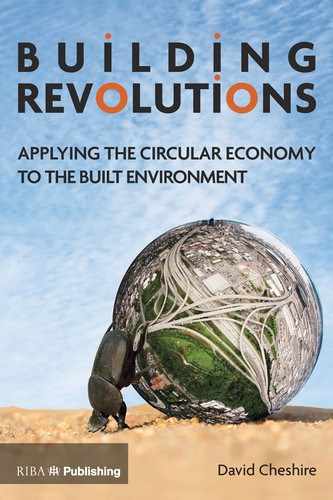14. Coming full circle
This book demonstrates that circular economy thinking can be applied to buildings and that there are opportunities for those that embrace the ideas to create new business models and designs that enable a transition to a more regenerative built environment.
The cases studies in this book show that there are some visionary and enterprising clients, designers, constructors and manufacturers who are capitalising on the opportunities presented by a circular economy. They have managed to overcome the barriers to change and the inertia in the system to differentiate themselves in the market.
These new ideas respond to the pressing need to slow and reverse the growing demand for raw materials and the related environmental and social impacts. By implementing these ideas, businesses can seize more control over their raw materials and protect themselves from supply disruptions and volatile prices while reducing their exposure to environmental legislation and the costs of waste disposal. Businesses can respond to the shift in the market by providing performance rather than products, allowing them to forge new longer-term relationships with their customers.
Cycling, not Recycling
Embracing the idea of a circular economy is so much more than just reducing waste arising on site, or recycling more waste. It is about fundamentally rethinking the way that buildings are designed, procured and used. It is about avoiding design that takes buildings down blind alleys, where there is no way back except depreciation, demolition and downcycling. It is about creating a built environment that retains the value of buildings, components and materials in a virtuous circle, while making buildings that are better for the environment and for people.
Thinking Beyond the Grave
This book outlines a set of design principles that interpret the circular economy model for the built environment. The trick is to think beyond the immediate demands for the building and to consider the potential next lives of the building and its components. The design principles aim to capture circular economy thinking and to apply it to building design, as follows:
- Design-out waste by refitting and refurbishing buildings in preference to demolition and building new, using waste as a resource to create new designs and using lean design principles to create buildings that use fewer resources and components and are less complex.
- Create structures that are built to last, that have layers that can be peeled off and replaced, that can be adapted to new uses and that can be disassembled and even reconfigured for different uses on new sites.
- Select building components that are carefully designed to flow in either a technical or a biological cycle, depending on their lifespan, use and what is available. The components in the technical cycle are designed to retain value, by being designed for reuse, remanufacture or disassembly. The biological materials remain uncontaminated and can be cascaded through different uses before being returned to the biosphere at end-of-life. Building components and materials in the technical cycle that are hard to salvage at end-of-life should be designed-out or perhaps replaced with biological materials.
Leaps and Bounds
New technologies and business models can leapfrog over current thinking and leave it standing, allowing industries to escape the bounds of convention.
3D printing, or additive manufacture, provides the potential to make beautiful components that do not need complex polymers or irreversibly bonded materials. New designs could be inspired by the way that nature uses structure and form to create stiffness, flexibility and even colour from its limited palette of materials. Additive manufacture reduces waste during production and, if applied correctly, could help to create components made from only a few polymers that are simpler to recycle at end-of-life.
Information technology is being used to locate potential sources of materials via online exchanges and resource maps. The materials and components in buildings can be fully catalogued using BIM so they can become materials banks for future generations. These inventories can be used to create a market for components within a building before it is demolished, which could be an incentive for it to be deconstructed rather than demolished, allowing items to be salvaged.
New business models show how thinking differently about ownership can enable valuable resources to be kept in high-value cycles, where manufacturers retain ownership of the product or incentivise return to ensure that components and materials are kept in circulation. There is also the potential for new local industries to be set up to remanufacture or reprocess products that would otherwise have been treated as waste.
Creating Revolutions
The Park 20|20 case study shows that it is possible to bring many of these design principles and concepts together to create buildings that are not only constructed from certified products and designed for adaptation and deconstruction, but also cost less to build, command higher rents and provide healthier internal environments.
The collaborative approach used by Delta Development allows it to have a direct relationship with the manufacturers and suppliers, which allows them to focus on materials and products selection, and to nurture innovative design solutions.
There is no need to wait for the policy landscape to shift or for the systemic problems in the industry to be resolved. With the right mindset, individuals and organisations can embrace this new agenda and create better buildings that leave a positive legacy for future generations.
